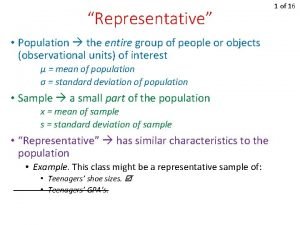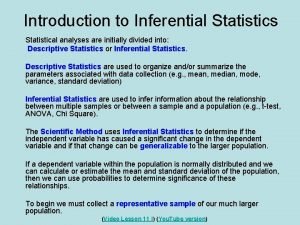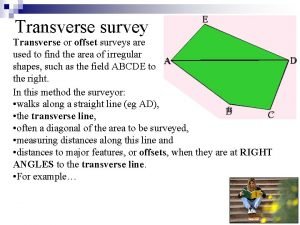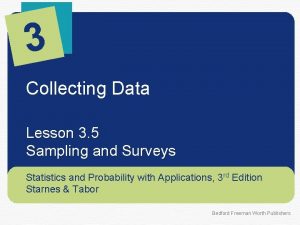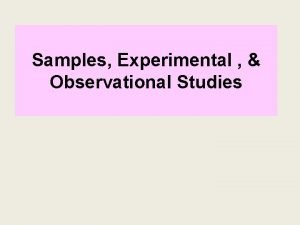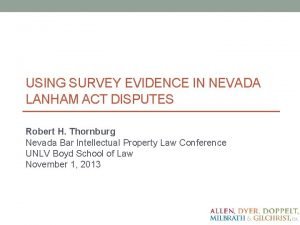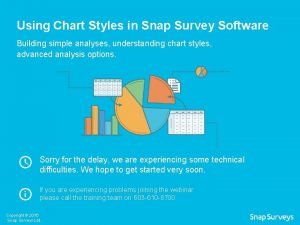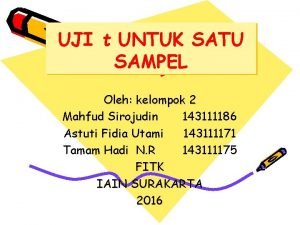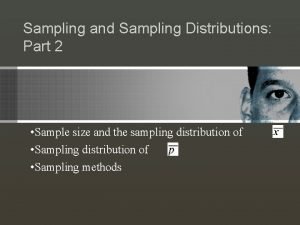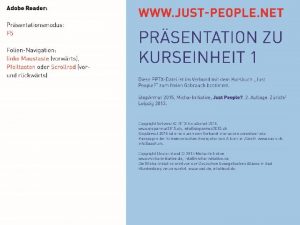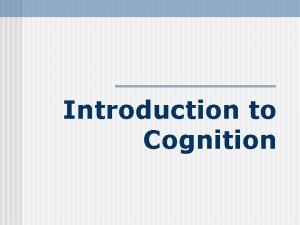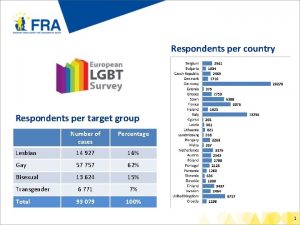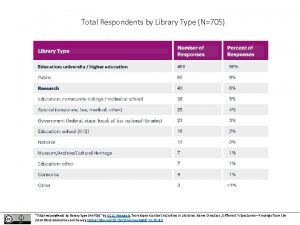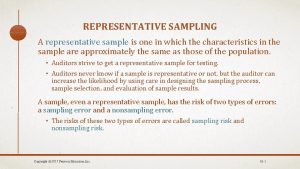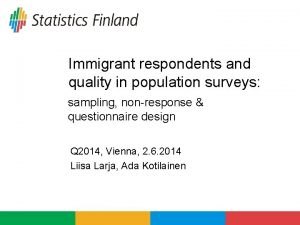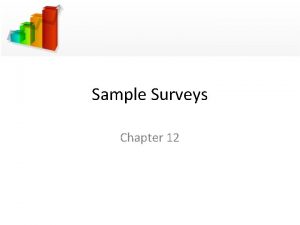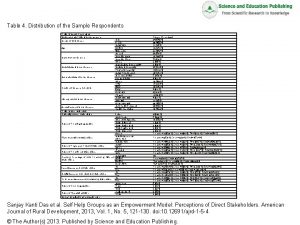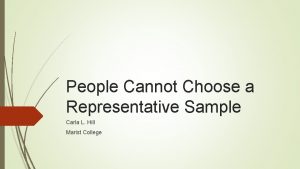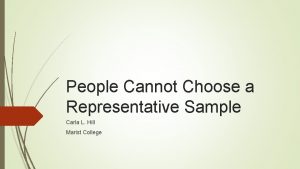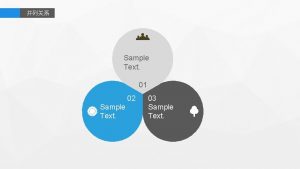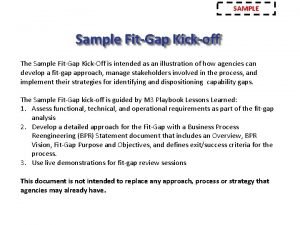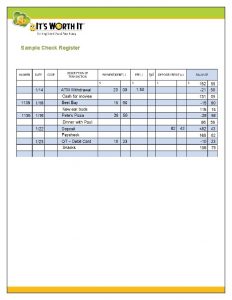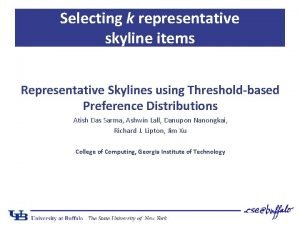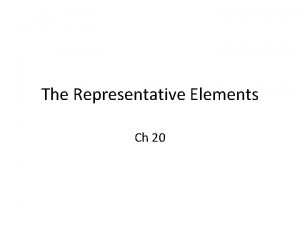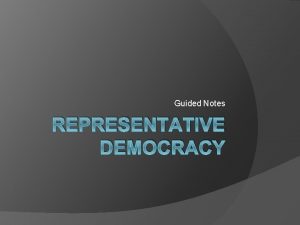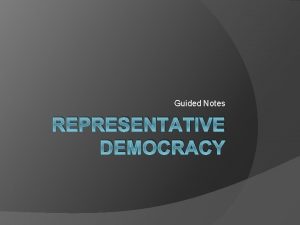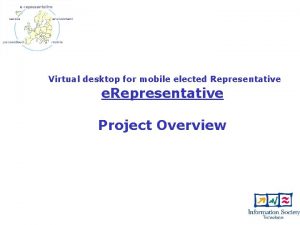Surveys Respondents are a representative sample of people


















































- Slides: 50

Surveys

Respondents are a representative sample of people

Surveys ask respondents for information using verbal or written questioning

Gathering Information via Surveys • • • Quick Inexpensive Efficient Accurate Flexible

Tree Diagram of Total Survey Error Random sampling error Total error Systematic error (bias)

Random Sampling Error • A statistical fluctuation that occurs because of change variation in the elements selected for the sample

Tree Diagram of Total Survey Error Random sampling error Total error Systematic error (bias)

Common Errors in Survey Research • Systematic Error –Also called Nonsampling Error –Results from • some imperfect aspect of the research design or • from a mistake in the execution of the research.

Tree Diagram of Total Survey Error Administrative error Systematic error (bias) Respondent error

Respondent Error • A classification of sample bias resulting from some respondent action or inaction • Nonresponse bias • Response bias

Nonresponse Error • Statistical difference between – a survey that includes only those who responded and – a perfect survey that would also include those who failed to respond • Nonrespondent – Person who is not contacted or who refuses to cooperate in the research – No Contact • Person who is not at home on the 1 st or 2 nd contact, or who is otherwise inaccessible. – Refusal • Person who is unwilling to participate in a research project

Response Bias • Bias that occurs when respondents either consciously or unconsciously tend to answer questions with a certain slant that misrepresents the truth. • Can arise from – The question format – The question content – Some other stimulus • such as the situation in which the question is asked • Deliberate falsification may occur when people misrepresent answers to appear intelligent, to conceal personal information, to avoid embarrassment, etc.

Tree Diagram of Total Survey Error Acquiescence bias Extremity bias Interviewer bias Auspices bias Social desirability bias

Acquiescence Bias • A category of response bias that results because some individuals tend to agree with all questions or to concur with a particular position.

Extremity Bias • A category of response bias that results because response styles vary from person to person; some individuals tend to use extremes when responding to questions.

Interviewer Bias • A response bias that occurs because the presence of the interviewer influences answers.

Auspices Bias • Bias in the responses of subjects caused by the respondents being influenced by the organization conducting the study.

Social Desirability Bias • Bias in responses caused by respondents’ desire, either conscious or unconscious, to gain prestige or appear in a different social role.

Tree Diagram of Total Survey Error Administrative error Systematic error (bias) Respondent error

Administrative Errors • Error caused by the improper administration or execution of the research task. • Caused by – Carelessness – Confusion – Neglect – Omission – Some other blunder

Tree Diagram of Total Survey Error Data processing error Sample selection error Interviewer cheating

Types of Administrative Errors • Data-Processing Error – Occurs because of incorrect data entry, incorrect computer programming, or some other procedural errors during the data-processing stage • Sample Selection Error – Caused by improper sample design or sampling procedure execution – Hoover vs. Roosevelt, 1932 Presidential Election

Types of Administrative Errors • Interviewer Error – Mistakes made by interviewers who fail to record survey responses correctly – Could also occur if selective perception causes interviewers to misrecord data that do not support their own attitudes and opinions • Interviewer Cheating – Practice by interviewers of filling in fake answers or falsifying questionnaires. – If suspect this, tell interviewers that a small percentage of respondents will be called back to confirm whether the initial interview was actually conducted

Classification of Survey Methods Telephone Personal Electronic Mail/Fax Interview In-Home Traditional Telephone Mail E-Mail Mall Intercept Computer-Assisted Telephone Interviewing Mail Panel Computer-Assisted Personal Interviewing Internet

Personal Interviews • Form of direct communication in which an interviewer asks respondents questions faceto-face.

Advantages of Personal Interviews • Opportunity for Feedback • Probing Complex Answers – Interviewer asks for clarification or expansion of answers • Length of Interview • Completeness of Questionnaires – Minimizes Item Nonresponse: failure by a respondent to answer a question on a questionnaire • Props & Visual Aids • High Participation

Disadvantages of Personal Interviews • Interviewer Influence • Lack of Respondent Anonymity • Cost

Types of Personal Interviews • Door-to-Door (In-Home) Interviews – Conducted at the respondent’s home or place of business • Mall Intercept Interviews – Personal interview conducted in a shopping mall or other high-traffic area

Aspects of Personal Interview • Speed of data collection – Slow to Moderate • Geographical flexibility – Limited to moderate • Respondent cooperation – Excellent • Versatility of questioning – Quite versatile

Aspects of Personal Interview • Questionnaire length – Long • Item nonresponse – Low • Possibility of respondent misunderstanding – Lowest

Aspects of Personal Interview • Degree of interviewer influence of answer – High • Supervision of interviewers – Low to Moderate • Anonymity of respondent – Low

Aspects of Personal Interview • Ease of call back or follow-up – Difficult • Cost – Highest • Special features – Visual materials may be shown or demonstrated; extended probing possible

Telephone Surveys

Telephone Surveys • Speed of Data Collection – Very fast • Geographical Flexibility – High • Respondent Cooperation – Poor • Versatility of Questioning – Moderate

Telephone Surveys • Questionnaire Length – SHORT!!!!!!!!!! • Item Nonresponse – Medium • Possibility of Respondent Misunderstanding – Average • Degree of Interviewer Influence of Answer – Moderate

Telephone Surveys • Supervision of interviewers – High, especially with central location WATS interviewing • Anonymity of respondent – Moderate • Ease of call back or follow-up – Easy

Telephone Surveys • Cost – Low to Moderate to High • Special features – Fieldwork and supervision of data collection are simplified; quite adaptable to computer technology

Self-Administered Questionnaires

Mail Surveys

Mail Surveys • Speed of data collection – Researcher has no control over return of questionnaire; slow • Geographical flexibility – High • Respondent cooperation – Moderate--poorly designed questionnaire will have low response rate

Mail Surveys • Versatility of questioning – Highly standardized format • Questionnaire length – Varies depending on incentive – Varies depending on whether business or consumer respondents • Item nonresponse – High

Mail Surveys • Possibility of respondent misunderstanding – Highest--no interviewer present for clarification • Degree of interviewer influence of answer – None--interviewer absent • Supervision of interviewers – Not applicable

Mail Surveys • Anonymity of respondent – High • Ease of call back or follow-up – Easy, but takes time • Cost – Moderate

Improving Response Rates Methods of Improving Response Rates Prior Notification Incentives Monetary Prepaid Follow-up Nonmonetary Promised Other Facilitators

E-Mail Questionnaire Surveys • Speed of data collection – Virtually Instantaneous • Geographic flexibility – worldwide • Cheaper distribution and processing costs

E-Mail Questionnaire Surveys • Flexible, but – Extensive differences in the capabilities of respondents’ computers and e-mail software limit the types of questions and the layout • E-mails are not secure and “eavesdropping” can possibly occur • Respondent cooperation – Varies depending if e-mail is seen as “spam”

Internet Surveys • Self-administered questionnaire posted on a site. • Respondents answer questions displayed online by highlighting a phrase, clicking an icon, or keying in an answer. • Many of the same advantages & disadvantages as E-Mail Surveys. • Key differences between Internet & E-Mail surveys: – Must rely on respondents coming to the site (and deciding to participate) – Data collection can be much slower


Internet & E-Mail Surveys Never forget: • Not all individuals in the general public have Internet access. • Many respondents lack powerful computers with high-speed connections to the Internet. • Many respondents’ computer skills will be relatively unsophisticated.

There is no best form of survey; each has advantages and disadvantages.
 Antigentest åre
Antigentest åre Chapter 3 research example
Chapter 3 research example Undercoverage bias
Undercoverage bias Representative sample in statistics
Representative sample in statistics Surveys.panoramaed.com/ecisd
Surveys.panoramaed.com/ecisd Transverse survey
Transverse survey Security survey purpose
Security survey purpose Survey of enacted curriculum
Survey of enacted curriculum Surveys.pano
Surveys.pano Partial discharge survey
Partial discharge survey Real eyes surveys
Real eyes surveys Internal client satisfaction survey
Internal client satisfaction survey A veterinarian surveys 26 of his patrons
A veterinarian surveys 26 of his patrons Theworxhub qa & surveys
Theworxhub qa & surveys Lit survey
Lit survey Rds web surveys
Rds web surveys Lesson 3.5 sampling and surveys
Lesson 3.5 sampling and surveys What is survey experiment or observation?
What is survey experiment or observation? Cadastral surveys
Cadastral surveys Observational survey examples
Observational survey examples Types of land surveys
Types of land surveys Surveys.panoramaed/everett
Surveys.panoramaed/everett Lanham act surveys
Lanham act surveys The enacted curriculum
The enacted curriculum Syndicated data sources
Syndicated data sources Paid surveys slovenia
Paid surveys slovenia Survey rebuttals
Survey rebuttals Www ons gov uk surveys
Www ons gov uk surveys Double barreled questions
Double barreled questions Highway surveys
Highway surveys Snap survey software
Snap survey software üinterest
üinterest Ncjmm
Ncjmm What is stratified sampling
What is stratified sampling Advantages of sampling
Advantages of sampling Cluster sampling vs stratified random sampling
Cluster sampling vs stratified random sampling Qualitative sampling
Qualitative sampling Contoh soal uji t satu sampel
Contoh soal uji t satu sampel Volunteer sample vs convenience sample
Volunteer sample vs convenience sample A random sample of 395 people were surveyed
A random sample of 395 people were surveyed People as media examples
People as media examples Transformed people transform people
Transformed people transform people People just people
People just people Where is the love black eyed peas lyrics
Where is the love black eyed peas lyrics Representative bias
Representative bias Financial sector definition
Financial sector definition Periodic table outline
Periodic table outline Federal fleet manager certification program
Federal fleet manager certification program Direct democracy political cartoon
Direct democracy political cartoon Representative particle?
Representative particle? Representative cell
Representative cell


